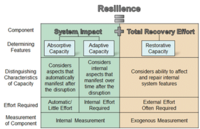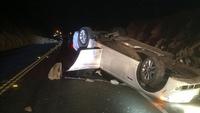-
Learning from ant colonies how to evacuate disaster zones
An escape route mapping system based on the behavior of ant colonies could give evacuees a better chance of reaching safe harbor after a natural disaster or terrorist attack by building a map of showing the shortest routes to shelters and providing regular updates of current situations such as fires, blocked roads, or other damage via the smart phones of emergency workers and those caught up in the disaster.
-
-
Long-term predictions for Miami sea level rise could be available soon
Researchers say that Miami could know as early as 2020 how high sea levels will rise into the next century. Scientists conclude that sea level rise is one of the most certain consequences of climate change. The speed and long-term height of that rise, however, are unknown. Some researchers believe that sea level rise is accelerating, some suggest the rate is holding steady, while others say it is decelerating. Scientists say that numbers should continue to be crunched every decade, creating more certainty in long-term planning — and helping develop solutions for a changing planet.
-
-
How building codes save homes from cyclones, and how they don’t
During Queensland’s preparations for Severe Tropical Cyclone Ita, Queensland Premier Campbell Newman advised residents who lived in older houses (those built before 1985) to evacuate their homes as they were not likely to stand up to the storm’s destructive winds. That was the year that building regulations changed to require new houses in cyclone-prone areas to be able to withstand higher winds. But how were these regulations determined, what do they mean for modern homes, and why do regulators always seem to wait until after a severe storm before updating the codes?
-
-
Extending terrorism insurance would save U.S. government money after future attacks
In the wake of the terrorist attacks of September 11, 2001, terrorism risk insurance quickly became either unavailable or very expensive. Congress reacted by passing the Terrorism Risk Insurance Act, which provides an assurance of government support after a catastrophic attack. This has helped keep terrorism risk insurance affordable for businesses. The program will expire at the end of this year and Congress is considering the appropriate government role in terrorism insurance markets.
-
-
Conventional theories about Titanic disaster are flawed
Previously it had been suggested that the seas which sank the famous cruise ship — which set off on its maiden voyage 102 years last week (Thursday 10 April 2014) — had an exceptional number of icebergs caused by lunar or solar effects. A new study finds, however, that the Titanic not unlucky for sailing in a year with an unusually high number of icebergs. In fact, the risk of icebergs higher now than it was in 1912.
-
-
California implements earthquakes’ lessons
In California, government engineers study structures that did not survive the earthquake, with plans to make improvements to building codes. The most important code changes tend to occur because earthquakes uncover weaknesses in contemporary construction standards.”Every time the earth shakes there’s something a little different about it,” says one official.
-
-
A grid of the right size could reduce blackout risk
Scientists argue that for every animal there is an optimal size — one which allows it to make best use of its environment and the physical laws that govern its activities, whether hiding, hunting, hoofing, or hibernating. Now, researchers are asking whether there is a “right” size for another type of huge beast: the U.S. power grid. The researchers believe that smaller grids would reduce the likelihood of severe outages, such as the 2003 Northeast blackout that cut power to fifty million people in the United States and Canada for up to two days.
-
-
Landscape shifts may influence where tornadoes touch down
Areas where landscape shifts from urban to rural or forest to farmland may have a higher likelihood of severe weather and tornado touchdowns, a new study says. An examination of more than sixty years of Indiana tornado climatology data from the National Weather Service’s Storm Prediction Center showed that a majority of tornado touchdowns occurred near areas where dramatically different landscapes meet — for example, where a city fades into farmland or a forest meets a plain.
-
-
Bangladesh tops list of countries at risk from sea level rise
Scientists say that see levels may rise by up to the feet by 2100.The implications of this would have drastic consequences for nearly all coastal nations, but the consensus is that Bangladesh will be the hardest hit by the change. Leading Bangladeshis say that since Bangladesh produces less than 0.3 percent of the emissions driving climate change, it would unjust for Bangladesh to rely on its own meager resources to solve this problem. One solution they offer: fifty million Bangladeshis (out of a population of 163 million) should be allowed to move to and resettle in the countries which produce the bulk of greenhouse gasses.
-
-
Coalition sounds alarm about possible global EMP disaster
A coalition that includes former speaker of the House Newt Gingrich and former CIA director James Woolsey has issued a terse warning regarding apocalyptic effects that could result from a mass EMP (electromagnetic pulse) disaster or attack. Members of the coalition “are convinced that our fragile electrical grid could be wiped out at any moment” from bursts of electrical energy caused by anything from a nuclear explosion to a solar flare from the sun, leading to chaos on a global scale.
-
-
Sandia to help cities be better prepared for, emerge stronger from, disasters

Sandia National Laboratories says it will bring its experience solving problems with practical engineering and modeling complex systems to cities around the world under a new agreement to support the 100 Resilient Cities Centennial Challenge, pioneered by the Rockefeller Foundation. The challenge, which will help thirty-three cities in its first year, seeks to make communities more resilient by being better prepared to withstand natural or manmade disasters, recover more quickly, and emerge stronger.
-
-
Roadmap outlines R&D path to reduce storm impacts
A new measurement science research and development (R&D) roadmap, prepared for the National Institute of Standards and Technology (NIST) over the past two years by a private-sector group of hazard mitigation experts, provides a broad strategic approach and R&D objectives to reduce impacts from windstorms and coastal inundations, including storm surge during hurricanes and tsunamis.
-
-
Friday L.A. tremor harbinger of quake worse than the Big One

Seismologists warn that a bigger earthquake along the Puente Hills fault, which produced the 5.1 magnitude tremor in Los Angeles last Friday, could cause more damage to the region than the anticipated “Big One” from the San Andreas Fault located on the outskirts of metropolitan Southern California. A 7.5-magnitude earthquake along the Puente Hills fault could kill 3,000 to 18,000 people and cause up to $250 billion in damages, leaving up to 750,000 people homeless. In contrast, an 8-magnitude earthquake along the San Andreas Fault would result in about 1,800 deaths.
-
-
Global insured losses from catastrophes were $45 billion in 2013
Total economic losses from natural catastrophes and man-made disasters were $140 billion in 2013. Global insured losses were around $45 billion in 2013, with large contributions from flooding and hail events. The economic losses of $140 billion were down from $196 billion in 2012, and below the 10-year average of $190 billion. Around 26,000 lives were lost in natural catastrophes and man-made disasters in 2013.
-
-
NIST issues final Joplin tornado report
The National Institute of Standards and Technology (NIST) has released the final report on its technical investigation into the impacts of the 22 May 2011 tornado that struck Joplin, Missouri. The massive storm was the single deadliest tornado in the United States in the sixty years that official records have been kept. The NIST Joplin tornado study was the first to study scientifically a tornado in terms of four key aspects: storm characteristics, building performance, human behavior, and emergency communication — and then assess the impact of each on preventing injury or death.
-
More headlines
The long view
Risk Assessment with Machine Learning
Researchers utilize geological survey data and machine learning algorithms for accurately predicting liquefaction risk in earthquake-prone areas.
